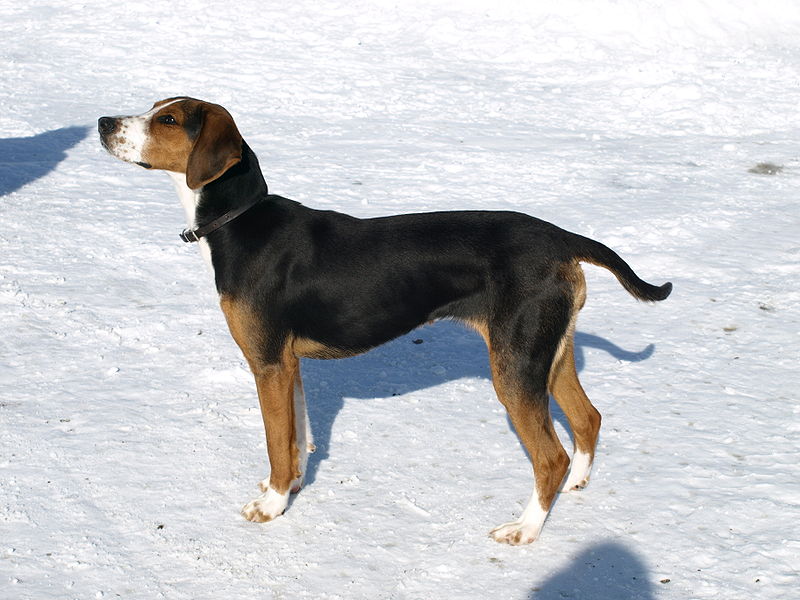


The Finnish Hound is a medium-sized breed from Finland, primarily bred for hunting purposes. Known for their excellent scenting ability, they are often used to track and hunt game such as hares, rabbits, and foxes. Finnish Hounds are highly energetic, intelligent, and independent, with a strong hunting drive. Despite their working background, they are friendly, loyal companions that enjoy spending time with their families. Their calm and friendly demeanor makes them suitable for both active individuals and families with an outdoor lifestyle. Due to their strong hunting instincts, early training and socialization are essential to ensure that they are well-behaved around other animals.
The Finnish Hound was developed in Finland in the late 19th century as a versatile hunting dog. It was bred by crossing native Finnish dogs with hounds from other countries, particularly English and French breeds. The goal was to create a dog with a keen sense of smell, endurance, and the ability to track and hunt in Finland's challenging terrain. The breed quickly gained a reputation for its exceptional scenting ability and ability to work in difficult conditions. The Finnish Hound has traditionally been used to hunt small game, such as rabbits and hares, and is still widely used in Finland for these purposes. The breed is not as well-known outside of Scandinavia, but it has gained recognition as a talented and hardworking hunting companion.
The Finnish Hound is a medium-sized dog with a well-muscled and athletic build. Males typically weigh between 45 to 55 pounds, while females are usually slightly smaller, weighing between 35 to 45 pounds. They stand between 19 and 22 inches tall at the shoulder. Finnish Hounds have a strong and muscular body, built for endurance and speed during long hunting trips. They have a short, dense coat that is weather-resistant, typically in a combination of black, tan, and white colors, with the most common pattern being a black saddle with tan markings on the legs, face, and chest. Their ears are medium-sized, slightly rounded, and set high, and their eyes are dark, expressive, and alert. Finnish Hounds have a long, straight tail that is carried high, which helps in communication and balance while running.
The Finnish Hound is known for its friendly, calm, and affectionate nature. While they were originally bred for hunting, they have a gentle disposition and are often very good with families and children. They are generally good with other dogs and animals, although they may have a strong prey drive due to their hunting background. Finnish Hounds are intelligent and independent dogs that enjoy problem-solving, but they can be stubborn at times, especially when they get distracted by smells. They are typically quiet and not overly vocal, making them relatively calm indoor pets when compared to some other breeds. However, due to their strong instincts and energetic nature, they do best in homes where they can receive plenty of physical and mental stimulation. Finnish Hounds form strong bonds with their families and are known for their loyalty and affectionate behavior.
The Finnish Hound is an energetic and active breed with high exercise needs. Originally bred for endurance hunting, they thrive when given regular opportunities to run, explore, and burn off energy. Daily exercise is essential for the breed, and they enjoy long walks, jogs, or runs. They also benefit from off-leash time in a secure, enclosed area where they can use their noses to track scents. Finnish Hounds are well-suited for active individuals or families who can provide them with outdoor activities and stimulating environments. While they enjoy outdoor activities, it’s important to keep them on a leash during walks, as they can be easily distracted by scents and may follow them, leading them to stray. Without sufficient exercise, they may become bored or develop undesirable behaviors such as digging or chewing.
The Finnish Hound is an intelligent and independent breed, which can make training a bit challenging at times. They are known for their strong scenting ability and natural hunting instincts, so training should be consistent, positive, and reward-based. Early socialization is important to ensure that they are well-behaved around other dogs, animals, and people. Because of their strong prey drive, they may be inclined to chase smaller animals or run off in pursuit of a scent, so early training on recall and basic obedience commands is essential. Finnish Hounds tend to bond closely with their families, so they generally respond well to training when it’s done in a calm and patient manner. Positive reinforcement methods such as treats, praise, and play are the best ways to motivate this breed during training sessions.
The Finnish Hound is generally a healthy breed, but like all dogs, they are prone to certain health conditions. Some common issues include hip dysplasia, ear infections (due to their floppy ears), and skin allergies. Regular veterinary check-ups and proper care can help catch any potential health problems early. Finnish Hounds are generally good about maintaining their own coat, but they benefit from periodic brushing to remove loose hair and prevent mats. Their short coat is easy to groom, and they typically only need a bath when necessary. Due to their active nature, they should be kept in a secure yard or taken for regular walks to keep them mentally and physically stimulated. Their ears should be checked and cleaned regularly to prevent infections. Additionally, regular dental care is recommended, including brushing their teeth and providing dental chews to maintain good oral health.
The average lifespan of the Finnish Hound is around 12 to 14 years. With proper care, including a balanced diet, regular exercise, and routine veterinary check-ups, many Finnish Hounds can live long and healthy lives. Like all breeds, genetics plays a role in lifespan, so it’s important to ensure they have the best possible care and living conditions to maximize their longevity.
© copyright Dog Compendium 2024 - 2025